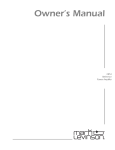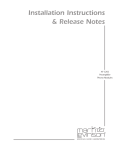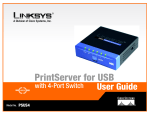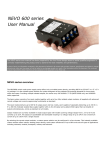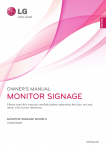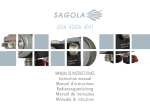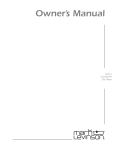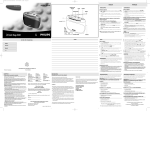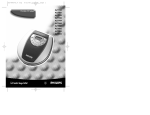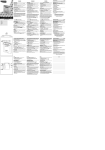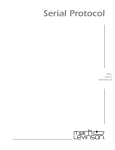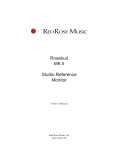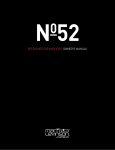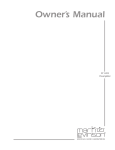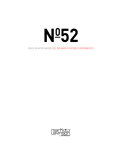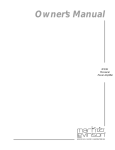Download Mark Levinson No535H User's Manual
Transcript
Owner’s Manual No500H Series Power Amplifier FCC Notice This equipment has been tested and found to comply with the limits for a Class B digital device, pursuant to Part 15 of the FCC Rules. These limits are designed to provide reasonable protection against harmful interference in a residential installation. This equipment generates, uses and can radiate radio frequency energy and, if not installed and used in accordance with the instructions, may cause harmful interference to radio communications. However, there is no guarantee that interference will not occur in a particular installation. If this equipment does cause harmful interference to radio or television reception, which can be determined by turning the equipment off and on, the user is encouraged to try to correct the interference by one or more of the following measures: • Reorient or relocate the receiving antenna. • Increase the separation between the equipment and the receiver. • C onnect the equipment into an outlet on a circuit different from that to which the receiver is connected. • Consult the dealer or an experienced radio/TV technician for help. Caution! Changes or modifications not expressly approved by the party responsible for compliance could void the user’s authority to operate the equipment. ii Canada This Class B digital apparatus complies with Canadian ICES-003. Cet appareil numérique de la Classe B est conforme à la norme NMB-003 du Canada. Mark Levinson is a registered trademark of Harman International Industries, Incorporated. Windows, Microsoft and Internet Explorer are registered trademarks of Microsoft Corporation in the United States and/or other countries. Other company and product names may be trademarks of the respective companies with which they are associated. For customer service and product shipment information, refer to the website: www.marklevinson.com Part No. 070-18187 | Rev 1 | 07/09 ©2009 Harman International Industries, Incorporated. All rights reserved. This document should not be construed as a commitment on the part of Harman International Industries, Incorporated. The information it contains is subject to change without notice. Harman International Industries, Incorporated, assumes no responsibility for errors that may appear within this document. Important Safety Instructions 1. Read these instructions. 2. Keep these instructions. 3. Heed all warnings. 4. Follow all instructions. 5. Do not use this apparatus near water. 6. Clean only with a dry cloth. 7.Do not block any ventilation openings. Install in accordance with the manufacturer’s instructions. 8.Do not install near any heat sources such as radiators, heat registers, stoves or other apparatus that produce heat. 9.Do not defeat the safety purpose of the polarized or grounding-type plug. A polarized plug has two blades with one wider than the other. A grounding-type plug has two blades and a third grounding prong. The wide blade or third prong is provided for your safety. If the provided plug does not fit into your outlet, consult an electrician for replacement of the obsolete outlet. 10.Protect the power cord from being walked on or pinched, particularly at plugs, convenience receptacles and the point where it exits from the apparatus. 11.Only use attachments and accessories specified by the manufacturer. 12.Use only with the cart, stand, tripod, bracket or table specified by the manufacturer or sold with the apparatus. When a cart is used, use caution when moving the cart/ apparatus combination to avoid injury or tip over. 13.Unplug this apparatus during lightning storms or when unused for long periods of time. 14.Refer all servicing to qualified service personnel. Servicing is required when the apparatus has been damaged in any way, such as when the power-supply cord or plug is damaged; liquid has been spilled or objects have fallen into the apparatus; or the apparatus has been exposed to rain or moisture, does not operate normally or has been dropped. 15.The MAIN'S cord is intended to be the safety disconnect device for this apparatus and shall remain readily operable at all times. 16.Ventilation should not be impeded by covering the ventilation openings with items such as newspapers, tablecloths, curtains and so on. 17.No naked flame sources, such as candles, should be placed on the apparatus. 18.Terminals marked with this symbol may be considered HAZARDOUS LIVE, and the external wiring connected to these terminals requires installation by an INSTRUCTED PERSON or the use of ready-made leads or cords. 19.This product must be terminated with a three-conductor AC mains power cord that includes an earth ground connection. To prevent shock hazard, all three connections must ALWAYS be used. Warning! To reduce the risk of fire or electric shock, do not expose this apparatus to rain or moisture. The apparatus shall not be exposed to dripping or splashing. No objects filled with liquids, such as vases, shall be placed on the apparatus. iii Mark Levinson Safety Terms & Symbols These terms may appear in this manual: Warning! Calls attention to a procedure, practice, condition or the like that, if not correctly performed or adhered to, could result in personal injury or death. Caution! Calls attention to a procedure, practice, condition or the like that, if not correctly performed or adhered to, could result in damage or destruction to part or all of the component. Note Calls attention to information that is essential to highlight. These symbols may appear on the product: Appears on the component to indicate the presence of noninsulated, dangerous voltage inside the enclosure – voltage that may be sufficient to constitute a risk of shock. iv Appears on the component to indicate important operation and maintenance instructions included in the accompanying documentation. Appears on the component to indicate compliance with the EMC (Electromagnetic Compatibility) and LVD (Low-Voltage Directive) standards of the European community. Documentation Conventions This document contains general safety and operation instructions for the Nº500H Series Power Amplifiers. It is important to read this document before attempting to use this product. Please pay particular attention to safety instructions. This manual is not intended as a general reference guide for audio or home theater systems. If you’re uncertain how to set up or maintain your system, seek the advice of a professional installer or ask your dealer for a recommendation. Nº500H Series Power Amplifier Table of Contents Introduction............................................................................... 2 Product Description..................................................................... 2 What’s in the Box......................................................................... 2 Product Registration..................................................................... 3 Installation Considerations......................................................... 3 Unpacking................................................................................... 3 Placement and Ventilation............................................................ 3 Power Requirements.................................................................. 4 Operating States.......................................................................... 5 Front Panel................................................................................ 6 Rear Panel................................................................................. 7 Network Setup......................................................................... 10 Material Requirements................................................................ 10 Computer Requirements ........................................................... 11 Connecting the Cables............................................................... 11 Internal Web Page..................................................................... 12 Network Setup Parameters......................................................... 12 Connecting With DHCP (Recommended).................................... 13 Setting Up the Computer........................................................... 14 Connecting With Static IP Addressing......................................... 15 Direct Connection...................................................................... 17 ML Net ................................................................................... 18 Masters and Slaves..................................................................... 18 Connecting the Devices............................................................. 18 Discovering Slaves..................................................................... 19 Status Reporting........................................................................ 19 Fault Reporting.......................................................................... 19 Troubleshooting....................................................................... 20 Fault Protection....................................................................... 22 ML Net Fault Conditions........................................................... 22 Restoring Factory Defaults....................................................... 23 Care & Maintenance................................................................. 23 Specifications........................................................................... 24 Declaration of Conformity........................................................ 26 1 Mark Levinson Introduction Thank you for purchasing the Nº531H, Nº532H, Nº533H or Nº535H Power Amplifier. True to Mark Levinson® tradition, the audio excellence and performance levels of the Nº500H series amplifiers are unrivaled in today’s marketplace. Product Description The Nº500H series amplifiers redefine the concept of outstanding performance in their categories. Drawing from the Mark Levinson heritage, while utilizing a new, straightforward, balanced, currentfeedback design, creates a new series of amplifiers that must be listened to in order to be fully appreciated. The final result is impressive, even for the Mark Levinson high standard of excellence. Independent power supply components are used for each channel to maximize the isolation between channels, thus improving imaging. Isolated chassis and signal grounds minimize noise to optimize detail, even at low listening levels. The amplifier channel itself is simple but elegant. Like the Nº532, the audio path is fully differential, thereby handling balanced input signals in their native format, ensuring no noise is added by unnecessary signal conversions. Care was taken in component selection, insuring high-quality passive components are used in critical locations, maximizing the potential sonic benefits. 2 The Nº500H Series amplifiers may be operated through a networkcapable Ethernet port for use with ML Net and external protocol controllers, and standard DC trigger controls. Embracing new technology with the same level of enduring excellence, the Nº500H Series amplifiers are each the finest in their category. Truly impressive output capabilities, combined with the high-power efficiency of all Mark Levinson amplifiers, make the Nº500H Series remarkably capable amplifiers, sure to impress even the most demanding of audio enthusiasts. What’s in the Box The shipping box includes: Item Quantity Power amplifier 1 Nº500H series owner’s manual (this document) 1 Heavy white gloves 2 pairs Cable with 3.5mm mini-plugs (for use with trigger) 1 Detachable AC power cord* 1 *varies by destination country Nº500H Series Power Amplifier Product Registration Register your Nº500H series amplifier online at www.marklevinson.com within 15 days of purchase. Retain the original, dated sales receipt as proof of warranty coverage. Installation Considerations The Nº500H series power amplifier requires special care during installation to ensure optimal performance. Pay particular attention to instructions included in this section and to precautions included throughout this owner’s manual. Unpacking DO save all packing materials for possible future shipping needs. DO inspect the amplifier for signs of damage during shipment. If damage is discovered, contact your authorized Mark Levinson dealer for assistance in making appropriate claims. DO locate and remove the accessory bag from the carton. Make sure it contains all of the items listed in the “What’s in the Box” table on the previous page. If not, contact your authorized Mark Levinson dealer. 3 Caution! DO NOT attempt to lift or move the power amplifier without adequate assistance. The shipping weight of the amplifier exceeds what a single person should lift alone. To avoid injury or damage to the unit, at least two people are required to lift or move the amplifier. Two pairs of knit white gloves with special gripping surfaces on the palms and fingers are ncluded with the amplifier. Wear these gloves when lifting or moving the amplifier. Placement and Ventilation DO install the power amplifier on its own shelf for proper ventilation. DO install the amplifier chassis on a solid, flat, level surface. DO install the power amplifier close to associated components to keep interconnecting cables as short as possible. DO select a dry, well-ventilated location out of direct sunlight. DO allow at least 3 to 4 inches (8 to 10cm) of clearance above and on each side of the amplifier for proper heat dissipation. Mark Levinson DO allow at least 6 inches (15cm) of clearance behind the amplifier so that the power cord and cables have space to bend without becoming crimped or strained. DO NOT place the amplifier chassis on a thick rug or carpet or cover the amplifier with a cloth, as this might prevent proper cooling. DO NOT obstruct the ventilation holes on the top and bottom of the chassis or reduce airflow through the amplifier. DO NOT place the amplifier chassis near low-level components. The power amplifier is capable of producing large output currents and hence significant magnetic fields, which can induce noise in sensitive components. DO NOT expose the power amplifier to high temperatures, humidity, steam, smoke, dampness, or excessive dust. Avoid installing near radiators and other heat-producing appliances. Warning! 4 MAKE SURE all components are properly grounded. Do not defeat the safety purpose of polarized or grounding-type plugs with “ground-lifter” or “cheater” adapters. Doing so may cause dangerous voltage to build up between components, which can result in personal injuries and/or product damage. Power Requirements The Nº500H series power amplifier is configured at the factory for 100, 120, or 230 VAC power operation at 50Hz or 60Hz. Before operating the amplifier, ensure that the power label on the rear panel near the AC input connector indicates the correct operating voltage. Caution! DO NOT attempt to adjust the operating voltage. Consult a Mark Levinson dealer if the operating voltage is incorrect or must be changed for relocation purposes. Different operating voltages may require the use of different power cords and/or attachment plugs. Contact a Mark Levinson dealer for additional assistance. The Nº500H series power amplifier is capable of passing remarkable sound at exceptional power levels. Depending on listening habits, loudspeaker demands, and the number of power amplifiers present in the system, it is possible that the electrical service may become the limiting performance factor of your system. Nº500H Series Power Amplifier If this case occurs, consider installing a dedicated AC circuit for the system. Contact a licensed electrician for assistance. If more than one AC circuit is providing power to the system, contact a licensed electrician to ensure that all components are operating with the same solid, low-impedance ground reference. Caution! Operating States Building regulations and electrical codes differ from location to location, making it impossible to anticipate the requirements of amplifier high-current AC circuits, such as the No500H series power amplifier is capable of using. Contact a local, licensed electrician for further information. The Nº500H series power amplifier is designed for continuous operation and has three operating states: • O ff – AC power is disconnected using the rear-panel Power switch or by removing the power cord from the rear panel. • tandby – this is an energy-saving mode. AC power is only S connected to the low-voltage power supply, so all nonaudio functions, such as ML Net and triggers, are active. • On – the amplifier is fully powered and all outputs are active. The amplifier should be unplugged during lightning storms and extended periods of nonuse as a precaution against potentially damaging power surges through the line. Caution! BEFORE moving the power amplifier, make sure it is powered off with the Power button. Then make sure the power cord is disconnected from the rear panel connector and the electrical outlet. 5 Mark Levinson Front Panel The front panel contains one LED and one Standby button – as shown. Status LED standby Standby Button Standby Button Places the amplifier into Standby mode. Pressing the button while the amplifier is in Standby mode turns on the amplifier. 6 Standby mode powers only the low-voltage power supply, control, and communication circuits. Status LED Indicates the operating state of the amplifier and provides basic diagnostic information if a fault condition occurs. The table below identifies the basic behavior of the Status LED. LED Behavior Description Fully lit Indicates that the amplifier is powered on. Slowly blinking Indicates that the amplifier is in Standby mode. Not lit Indicates that the amplifier is powered off. Refer to the “Troubleshooting” section in the back of the manual for a description of the Status LED behavior when a fault is detected. Nº500H Series Power Amplifier Rear Panel The images below show a one-channel, two-channel, three-channel and five-channel rear panel view. Audio Input Ethernet Port Trigger Input/Output Nº531H Monaural Power Amplifier (1 x 300W) Power Switch Loudspeaker Binding Posts AC Input Audio Input Ethernet Port Trigger Input/Output Nº532H Dual-Channel Power Amplifier (2 x 300W) Power Switch Loudspeaker Binding Posts AC Input Audio Input Nº533H Three-Channel Power Amplifier (3 x 300W) Ethernet Port Trigger Input/Output Power Switch Loudspeaker Binding Posts AC Input 7 Nº535H Five-Channel Power Amplifier (5 x 200W) Audio Input Loudspeaker Binding Posts Ethernet Port Trigger Input/Output Power Switch AC Input Power Switch Controls the AC power to the input of the amplifier when a power cord is connected from the electrical outlet to the AC input connector on the rear panel. When the Power switch is pressed to turn on the unit, the amplifier enters the Standby mode. Note The audio outputs of this power amplifier are considered Class 2 (CL2) circuits in North America. This means the wire connected between this amplifier and the speaker(s) shall be rated at minimum Class 2 (CL2) and shall be installed according to the U.S. National Electrical Code (NEC) Article 725 or Canadian Electrical Code (CEC) Section 16. Mark Levinson Audio Channel Inputs One balanced and one single-ended (unbalanced) connector is available for each audio channel input. Single-Ended Inputs The RCA connectors accept single-ended signals from preamplifiers with singled-ended (RCA) outputs. A small toggle switch is provided to select either the balanced (XLR) or single-ended (RCA) input connector on each channel. Pin 2 If your preamplifier does not support a balanced connection to the power amplifier, connect the single-ended output to the RCA input on the amplifier. Make sure the toggle switch is set to the position closest to the RCA connector. Pin 1 Balanced Inputs Pin 3 Accepts a signal from a preamplifier with balanced outputs via the high quality XLR connector. Make sure the toggle switch is set to the position closest to the XLR connector. Push Balanced (female XLR) Input Connector Pin Assignments: Pin 1: Signal Ground Pin 2: Signal + (non-inverting) Pin 3: Signal - (inverting) Connector Shell - Chassis Ground 8 Loudspeaker Binding Posts The pin assignments, shown on the left, of the XLR-type female input connector are consistent with the standards adopted by the Audio Engineering Society. Refer to the operating manual of your preamplifier to ensure that the pin assignments of its balanced output connectors correspond to the Mark Levinson power amplifier. If not, wire the cables so that the appropriate output pin connects to the equivalent input pin. The Nº531H, 532H and 533H utilize custom-made, gold-plated, high-current loudspeaker binding posts, two for each output channel. The Nº535H uses different high-current binding posts due to space constraints. The positive binding posts, labeled + (positive), are red; the negative binding posts are black and are labeled – (negative). Note Ensure when connecting the loudspeaker that at least one positive and one negative binding post is used. There is NO ground reference. Caution! Be careful to not short the positive and negative outputs together. Do not short the positive or negative outputs to chassis or any other safety ground. The amplifier must be powered off during installation and whenever input and/or output cables are being connected. Nº500H Series Power Amplifier Banana plugs can also be used to connect the speaker cables to the loudspeaker binding posts. Banana plugs are not available on the 230 VAC model. Caution! DO NOT OVERTIGHTEN the binding posts. The innovative design of these binding posts provides more leverage; hence, high-contact, tight pressure connections are achieved when finger-tightened. DO NOT FORCE the binding post “wings” over a bent or oversized connector. Doing so may damage the binding post. Trigger Input and Output The rear panel of the amplifier has two trigger connectors – one input and one output. The trigger input can receive a 3-12V DC signal from a connected component. The trigger output passes through the trigger input signal, enabling a daisy-chain of amplifiers to be controlled by a single trigger signal. The triggers enable the power amplifier to be automatically powered on or put into Standby mode, by the state of other devices in the system. The trigger output can also affect other power amplifiers in the same manner. Receiving a trigger signal causes the amplifier to change its power state. If the amplifier is powered on, then 0V on the trigger signal puts the amplifier into Standby or mode. Conversely, an amplifier in Standby mode is powered on when 3-12VDC is received on the trigger input. Ethernet Port The Ethernet port is a standard 10Base-T connection for use with external control and networking. The Nº500H series supports connection to a router or network, and to a PC-compatible computer. This connection is designed for use with proprietary Mark Levinson external controllers, such as ML Net, or can provide serial port control. For a list of the serial commands available, refer to the separate document, No. 5 series Power Amplifier Serial Protocol Definitions. AC Input Provides AC power to the amplifier when the supplied power cord is connected from the AC Input connector on the rear panel to an electrical outlet. Caution! Before operating the amplifier, verify that the voltage label near the AC input connector indicates an operating voltage compatible with the voltage level of the electrical outlet you intend to use. 9 Mark Levinson Network Setup The Nº500H series power amplifier supports a network connection through the Ethernet port. The Nº500H series can connect to a network through use of a router or directly to a computer. The Nº500H series can be: 1.Connected to a router with DHCP active – We highly recommend using this option. Since the DHCP (Dynamic Host Configuration Protocol) automatically assigns the IP (Internet Protocol) addresses, setup is much simpler. 2. C onnected to a router with DHCP not active – This method requires more advanced networking knowledge to set up because it uses fixed static IP addressing. 3. Connected directly to a computer with no router – We recommend only using this option when a router is not available. This method requires more advanced networking knowledge to set up because it uses fixed static IP addressing and a special network crossover cable. This section provides general instructions for all three methods. 10 Material Requirements Note The following materials are required to connect the Nº500H series to the network with a router: • Nº500H series power amplifier • Two twisted-pair network cables • PC-compatible computer with 10/100Base-T network card • 10/100Base-T router The Nº500H series does not support wireless connection. However, a cable attached from the amplifier to a wireless adapter can be used to interface with a wireless network. The following materials are required to connect the Nº500H series to a computer without the use of a router: • Nº500H series power amplifier • Network crossover cable • PC-compatible computer with 10/100Base-T network card Nº500H Series Power Amplifier Computer Requirements Note Connecting the Cables The PC-compatible computer used to connect to the Nº500H series must have the following software installed: • Windows® 2000 or Windows XP® • eb browser (Microsoft® Internet Explorer® 6.0 or higher W preferred) If DHCP is not active, the computer must be set up with a Static IP address. Refer to the “Setting Up the Computer” procedure found later in this section for instructions. The Nº500H series can be connected to the computer in two ways – through a router or directly to the computer. Before connecting the cables, ensure that the computer and the amplifier are powered down. To Connect Using a Router: Router 11 Computer Amplifier 1.Connect a network cable from the router to the Ethernet port on the rear panel of the amplifier. 2.Attach a second network cable from the router to the Ethernet port of the computer. To Connect Without a Router: Use a network crossover cable to connect the amplifier directly to the computer. Different from a standard network cable, the crossover cable is designed to connect network access ports directly together without a hub, router, or switch. Crossover Cable Amplifier Computer Connect the crossover cable from the Ethernet port on the rear panel of the amplifier to the Ethernet port of the computer. Mark Levinson Internal Web Page When connected to a computer, the Nº500H series has an internal Web page that provides access to: • etwork Setup – allows the user to modify the network setup N parameters. Accessing the internal Web page is the ONLY way to modify the network setup parameters of the Nº500H series amplifier. • tatus Information – provides basic status information of S the Nº500H series amplifier. • rror Reporting – tracks system-related error messages for E the Nº500H series amplifier. This page is a diagnostics tool for Mark Levinson Customer Service use. The amplifier MUST be connected to a computer via the Ethernet port before you can access the internal Web page. Continue to the next section – “Network Setup” – for further instructions. The Web page also has a Restore Defaults button, which resets the parameters to their factory default values. Clicking the Restore Defaults button displays a pop-up asking for confirmation; click Yes to restore the factory default values. 12 Network Setup Parameters Accessible only through the Nº500H series internal Web page, the network setup parameters include: • tatic IP Address – provides a fixed IP address. This IP S address is NOT automatically selected; it must be entered. If DHCP is on, then this parameter is not used. IP address 192.168.50.5 is the factory default value for the Nº500H series. Nº500H Series Power Amplifier • S ubnet Mask – identifies the subnet mask for the Nº500H series. This IP address is automatically assigned by DHCP. If DHCP is off, then the address must be entered manually and must agree with the subnet mask address of the router. IP address 255.255.255.0 is the factory default value for the Nº500H series. • ost Name – indicates the network name given to the H Nº500H series amplifier. This host name is unique to each amplifier and is comprised of two parts, separated by an underscore. The first part contains one to eight characters that can be modified via the internal Web page of the amplifier. he second part of the host name contains the last six T characters of the MAC address. This MAC address is unique to each Nº500H series amplifier. The default is “NO500H_xxxxxx” where “x” stands for the last six characters of the unique MAC address for that amplifier. • D HCP – turns the DHCP capability on or off. When activated, DHCP assigns a unique IP address to the Nº500H series. The factory default value is On. We recommend leaving DHCP set to On. Connecting With DHCP (Recommended) Use this procedure if you are using a router with DHCP active to connect to the amplifier. Otherwise, skip to the next procedure. 1. Connect the amplifier to the router, as described in the earlier “Connecting the Cables” procedure. Make sure that everything is powered off before making cable connections. 2. T urn on the PC and router. Verify that the router has DHCP active. 3. Press the Power button on the amplifier. 4. On the computer, open the Internet Explorer Web browser. 5. T ype “http://NO500H_xxxxxx” on the address line (URL). The “x” characters stand for the last six characters of the unique MAC address for that amplifier. 6. Press Enter. I f Internet Explorer is unable to find the amplifier, then you must find the IP address that was assigned to the amplifier by the router. If required, refer to your router’s owner’s manual for further details. Repeat this step using the IP address for the amplifier that was assigned by the router. 7. The Home tab of the amplifier’s internal Web page is now displayed. The tab is in red text to indicate that it’s the current page. The network connection is now complete. 13 Mark Levinson Setting Up the Computer Note If DHCP is not used, then the computer must be set up too. Use this procedure to set up the computer, then continue to the next procedure to connect to the amplifier. For the computer to find the amplifier, the LAN (Local Area Network) and TCP/IP (Internet Protocol) settings of the computer must be set up. The parameter setups vary slightly depending upon the operating system of the computer. Refer to the procedure below that matches the operating system on your computer. Due to your preference settings in the Windows operating system, the names and order of the dialog boxes may vary slightly from these instructions. Network Setup for Windows XP 1. From the Start menu, select Control Panel. 2. Double-click on the Network Connections option. 3. Double-click on the Local Area Connection option. 14 4. Click the Properties button to open the Local Area Connection Properties menu. If the computer is not currently connected to an active network, Step 3 has already opened the Local Area Connection Properties menu. 5. C lick on the Internet Protocol (TCP/IP) line item so that it is highlighted. 6. Click the Properties button. 7. S elect the “Use the following IP address” option. The IP address, Subnet mask, and Default gateway boxes are no longer grayed out and can now be modified. 8. Enter the following values: • IP address: 192.168.50.x – where x stands for a number other than 0, 3, 4, 5 or 255 • Subnet mask: 255.255.255.0 • Do not enter a value in the Default gateway parameter The computer must have a unique address and be on the same subnet as the amplifier. 9. Click “OK” to save and exit the menu. 10. Open the Internet Explorer Web browser. 11. From the menu bar, select the Tools Internet Options menu. 12. Select the Connections tab. 13. Click the LAN Settings button. 14. Verify that “Use a proxy server for your LAN” is NOT checked. 15. Click “OK” to save and exit the menu. Nº500H Series Power Amplifier Network Setup for Windows 2000 1. From the Start menu, select Settings Control Panel. 2. Double-click on the Network and Dial-Up Connections option. 3. Double-click on the Local Area Connection option. 4.Click the Properties button to open the Local Area Connection Properties menu. If the computer is not currently connected to an active network, Step 3 has already opened the Local Area Connection Properties menu. 5. C lick on Internet Protocol (TCP/IP) line item so that it is highlighted. 6. Click the Properties button. 7. S elect the “Use the following IP address” option. The IP address, Subnet mask, and Default gateway boxes are no longer grayed out and can now be modified. 8. Enter the following values: • IP address: 192.168.50.x – where x stands for a number other than 0, 3, 4, 5 or 255 • Subnet mask: 255.255.255.0 • Do not enter a value in the Default gateway parameter The computer must have a unique address and be on the same subnet as the amplifier. 9. Click “OK” to save and exit the menu. 10.Open the Internet Explorer Web browser. 11. From the menu bar, select the Tools Internet Options menu. 12. Select the Connections tab. 13. Click the LAN Settings button. 14. Verify that “Use a proxy server for your LAN” is NOT checked. 15. Click “OK” to save and exit the menu. Connecting With Static IP Addressing Use this procedure if you plan to connect with static IP addresses (DHCP is turned off). Otherwise, skip to the next procedure to connect directly to a computer. For the computer to find the amplifier, the TCP/IP and LAN settings of the computer must be set up. Refer to the previous “Setting up the Computer” procedure for instructions. 1. Connect the amplifier to the router, as described in the earlier “Connecting the Cables” procedure. Make sure that everything is powered off before making cable connections. 2. T urn on the PC and the router. Verify that the router has DHCP turned off, if required. 15 Mark Levinson 3. S et up the router to the IP address 192.168.50.x – where x stands for a number other than 0, 3, 4, 5, 255, or the number used for the computer IP address. The router must be on the same subnet as the amplifier and the computer, but also must have its own unique address. Refer to the router’s owner’s manual for instructions on how to modify the IP address. 4. Press the Power button on the amplifier. 5. On the computer, open the Internet Explorer Web browser. 6.On the address (URL) line, type in the static IP address of the amplifier preceded by "http://"and press Enter. (For example, "http://192.168.50.10") There may be a short delay before the amplifier Web page loads. 7.The Home tab of the amplifier’s internal Web page is now displayed. The tab is in red text to indicate that it is the current page. 8.Observe that the Status section of the Web page identifies the host name of the amplifier. The host name can be modified, but only the first eight characters are affected; anything after the underscore may not be modified. To change the host name of the amplifier: A. Type the new name into the white box to the right of the parameter. The new name must be made from the capital letters, A to Z, and the numbers, 0 to 9. Underscores may also be used. Only eight characters are allowed. 16 Note The host name MUST start with an alpha-character (A to Z). This is a standard networking rule. B. Click the Submit button to save the new value. C. Click the Refresh button in the Status section of the Web page to observe the new host name. 9.Observe that the Status section of the Web page also identifies the IP address of the amplifier. The static IP address can be modified, if desired. To change the IP address of the amplifier: A. Type the new IP address into the white box to the right of the parameter. B. Click the Submit button to save the new value. C. Enter the new IP address of the amplifier into the browser. The amplifier Web page loads, reflecting the new information. The network connection is now complete. Nº500H Series Power Amplifier Direct Connection Use this procedure to connect directly to a computer if you are not using a router. For the computer to find the amplifier, the TCP/ IP and LAN settings of the computer must be set up. Refer to the earlier “Setting up the Computer” procedure for instructions. 1. Connect the amplifier to the computer, as described in the earlier “Connecting the Cables” procedure. Make sure that both the amplifier and the computer are powered off before connecting. 2. Press the Power button on the amplifier. 3. On the computer, open the Internet Explorer Web browser. 4. On the address (URL) line, type in the static IP address of the amplifier preceded by "http://"and press Enter. (For example, "http://192.168.50.10") There may be a short delay before the amplifier Web page loads. 5. The Home tab of the amplifier’s internal Web page is now displayed. The tab is in red text to indicate that it is the current page. 6. Observe that the Status section of the Web page identifies the host name of the amplifier. The host name can be modified, but only the first eight characters are affected; anything after the underscore may not be modified. Note To change the host name of the amplifier: A. Type the new name into the white box to the right of the parameter. The new name must be made from the capital letters, A to Z, and the numbers, 0 to 9. Underscores may also be used. Only eight characters are allowed. The host name MUST start with an alpha-character (A to Z). This is a standard networking rule. B. Click the Submit button to save the new value. C. Click the Refresh button in the Status section of the Web page to observe the new host name. 7. Observe that the Status section of the Web page also identifies the static IP address of the amplifier. The static IP address can be modified, if desired. To change the IP address of the amplifier: A. Type the new IP address into the white box to the right of the parameter. B. Click the Submit button to save the new value. C. Enter the new IP address of the amplifier into the browser. The amplifier Web page loads, reflecting the new information. The network connection is now complete. 17 Mark Levinson ML Net The ML Net protocol allows you to control two or more Mark Levinson products simultaneously via the Ethernet port. Note Masters and Slaves Since ML Net operates through the use of a router and the Ethernet connection, all devices must have networking capability. Refer to the previous section of this manual, “Network Setup,” to set up the Nº500H series for network operation. ML Net uses a single “Master” device to control specific functions of other ML Net-capable Mark Levinson products. An ML Net system can only have one Master device; all other devices in the system become “Slaves”. Slave devices receive and respond to the commands of the master device. The Nº500H series power amplifier is always a slave device. A separate master device must be used in conjunction with the Nº500H series amplifier. As a slave device, the amplifier responds to the following ML Net commands sent from the master device: 18 • tatus Reporting – status conditions of the Nº500H S series slave(s) are reported to the master device; status includes Temperature, Session Time, Total On Time, and Fault Reporting. • S tandby State – the master device controls the Standby state of the amplifier. • S ynchronized LEDs – the Standby LEDS of the master device and all assigned slave devices blink in unison. Connecting the Devices After configuring each device on the network, connect all of the devices together. Ensure that all components are powered off or in Standby mode before connecting to the Ethernet ports. Each device must be connected to the same network and use the same subnet. Refer to the “Network Setup” section for instructions on how to connect the Nº500H series to the network. If more devices are desired than the router can handle, connect the additional devices first to a switch, then connect the uplink of the switch to a normal port on the router. Nº500H Series Power Amplifier The figure below illustrates a typical ML Net setup: Nº532 Media Console (Master) Nº500 Series Power Amplifier #1 (Slave) Router Nº500 Series Power Amplifier #4 (Slave) Nº500 Series Power Amplifier #3 (Slave) Nº500 Series Power Amplifier #2 (Slave) Discovering Slaves Status Reporting Before the master device can control any slave device, the slave devices must be “discovered” and assigned to the master device. Refer to the Owner’s Manual of the designated master device for further information about discovering and assigning slave devices. The Nº500H series slave(s) can report the following status information to the master device: • T emperature – the current operating temperature of the amplifier(s). • S ession Time – the amount of time that the amplifier(s) has been powered on. • otal On Time – the total amount of hours that the T amplifier(s) has been powered on since its manufacture. If a slave device is inactive, unassigned, or assigned to a different master, then status information is not available. Fault Reporting The Nº500H series slave(s) also reports fault information to the master device. If a slave device is inactive, unassigned, or assigned to a different master, then error reporting is not available. For more information about possible fault conditions, refer to the “Troubleshooting” section of the manual. 19 Mark Levinson Troubleshooting Incorrect operation is sometimes mistaken for malfunction. If problems occur, use this section for troubleshooting information. If problems persist, contact your authorized Mark Levinson dealer. No Power 1. E xamine the power cord to ensure that it is connected to both the rear panel connector of the amplifier and an electrical outlet. 2.Make sure the amplifier is powered on with the Power switch. 3. Make sure the amplifier is not in Standby mode. The front panel LED should be at full brightness. 4. E xamine the electrical circuit breaker to ensure that power is being supplied to the electrical outlet to which the amplifier is connected. 5. V erify that the voltage rating on the rear panel of the amplifier matches the voltage rating of the electrical outlet. If the voltages do not match, no power is sent to the outputs of the amplifier. 20 No Output 1. Make sure that the source device is powered on, playing audio, and set to the right output connector. 2. Examine cables to ensure a solid connection between the amplifier and associated components. 3. Make sure the amplifier's output connectors are connected to operational loudspeakers. 4. Ensure that the amplifier is not in a fault condition. When the amplifier experiences a fault, the output is muted and the Status LED on the front panel blinks in a rapid pattern, indicating: LED Behavior Description Rapidly blinking (on most of the time) Indicates that a power-related fault has occurred. Rapidly blinking (on half of the time) Indicates that a signal-related fault* has occurred. Rapidly blinking (off most of the time) Indicates that a thermal-related fault has occurred. *Signal-related faults include significant DC offset at the output due to either DC in the input signal or a failed component within the amplifier OR excessive current demands due to a short-circuited loudspeaker wire. Can’t Assign in ML Net You must assign the slave from the master device. Verify that the slave you want to assign is listed in the master device list and check its current state. For further explanations on assigning slave devices, refer to the owner’s manual of the master device. Nº500H Series Power Amplifier No Response to Commands in ML Net 1. Verify that the master device and the Nº500H series amplifier are properly connected together with a router. 2. Verify that the Nº500H series amplifier’s network setup is correct. Access to the internal Web page via a computer is required to verify the network settings of the Nº500H series. No Connectivity Via Ethernet • V erify that the network cables are properly connected between the router, switch, or hub and the amplifier. If connecting to a computer, verify that the computer network cable is in the correct port. • V erify the age of the router, switch, or hub. There may be a communication issue with the Nº500H series and older network devices. Power cycle the Nº500H series and use a newer router, switch, or hub between the network and the amplifier. • I f connected directly to the computer, make sure a crossover cable is used. • Verify that the router and computer have valid IP addresses. • V erify that the proxy server in the computer’s network setup is disabled. An active proxy server can interfere with the software upgrade procedure. • I f the web browser cannot find the host name of the amplifier, verify the following: If All Else Fails... • Ensure that the local DNS server is properly configured. We recommend configuring the local DNS Server to “DNS Forwarding” mode. To configure the DNS Server, refer to the setup manual of the server. • If using a subdomain, enter the complete address into the browser. For example, http://NO500H.yourhome.network.com • Enter the IP Address of the amplifier into the browser. For example, “http://192.168.50.5” 1. Power-cycle the Nº500H series, waiting at least 10 seconds between powering the amplifier off and on. 2. Restore the default settings on the internal web page. 3. V isit www.marklevinson.com and search the knowledgebase for more information. 4. Contact your Mark Levinson dealer. . 21 Mark Levinson Fault Protection The Nº500H series is designed to prevent damage to themselves and associated components. These extensive features protect both the critical circuitry of the amplifier itself and shield connected loudspeakers from serious damage due to high-power levels. Basic protections designed into the Nº500H series include fuses on each amplifier channel to protect against excessive current conditions, such as driving shorted outputs. Inrush limiting prevents premature aging of the power supply components during power-up; once the power supply has been charged, this feature goes off-line until the amplifier is powered up again. The Nº500H series actively monitors operating temperature, output current demands and the presence of DC on the outputs. The amplifier will shut down under any of these conditions and report the fault via the front panel LED and over the Ethernet connection. The amplifier must be shut down to clear the fault condition before being powered back up. ML Net Fault Conditions 22 The slave devices in an ML Net system can report fault conditions to the master device. Fault condition reports are displayed on the display of the master device when the fault occurs. Some faults may cause the amplifier to enter Standby mode. Power-cycling the amplifier clears the fault condition, providing the fault condition no longer exists. Note Some faults do not allow power to be reapplied to the amplifier until the fault condition no longer exists to protect the amplifier from damage. The fault conditions reported are: • lave Device DC Offset – indicates that the Nº500H series S amplifier is experiencing a signal-related fault. • lave Device Over Current – indicates that the Nº500H S series is experiencing an over-current condition. • S lave Device Over Temperature – indicates that the Nº500H series amplifier is overheating. • S ignal – indicates that the Nº500H series has experienced a general signal fault. Nº500H Series Power Amplifier Restoring Factory Defaults Pressing the Factory Default button on the internal Web page of the amplifier resets all settings to their factory default values. If the internal Web page is not available, there is also a key press sequence available. Follow the instructions below to reset the factory default settings from the front panel. 1. Power off the amplifier. 2. Press and hold the Standby button. 3. Press the Power button to turn on the power. 4. K eep holding down the Standby button until the front panel LED blinks four times. 5. Release the Standby button. Now reset to its factory default state, the amplifier will reinitialize. Care & Maintenance The Nº500H series amplifier requires routine care and maintenance to ensure optimal performance. The bulleted items indicate maintenance procedures that should be performed on a regular basis. Turn off the Nº500H series amplifier and unplug the rear AC power cord before performing maintenance to the amplifer. Note Failure to perform the maintenance procedures included in this section may void the manufacturer’s warranty and/or standard repair policies. • T o remove dust from the amplifier’s exterior surface, use a feather duster or a low-pressure blower. • T o remove dirt and fingerprints from the amplifier’s exterior surface, use a soft, lint-free cloth. DO NOT use metal polish or a cloth made with steel wool. • I f needed, this cloth can be dampened with isopropyl alcohol. DO NOT dampen the cloth with Benzene, acetone-based cleaners, or other commercial cleaners. • W ipe the amplifier’s exterior surface in the same direction as the grain of the brushed aluminum. Caution! DO NOT apply liquid directly to the amplifier’s exterior surface. Doing so may damage electrical components. 23 Mark Levinson Nº531H, 532H, 533H Specifications All specifications are subject to change without notice. Input & Output Connectors Control Connectors 24 • one balanced XLR input per channel • one unbalanced RCA input per channel • one pair “Hurricane” loudspeaker outputs with banana-plug sockets per channel (banana-plug socket not available on the 230 VAC models) • one Ethernet 10Base-T port • one 3.5mm mono (tip/sleeve) mini plug trigger input, 3-12Vdc • one 3.5mm mono (tip/sleeve) mini plug trigger output, 3-12Vdc • 3-pin IEC standard power connector Rated Output Power 20Hz to 20kHz at <0.5% THD, 300W per channel @ 8 Ω, full output from 2.25Vrms Frequency Response within 0.5dB from 10Hz to 20kHz Signal-to-Noise Ratio >85dB, reference level: 2.83 Vrms Input Impedance Voltage Gain Input Sensitivity Power Requirements Dimensions* 60 kΩ (balanced); 30 kΩ (unbalanced) 26.8dB 2.83Vrms output at 130mVrms input 100V~, 120V~, 230V~, factory set for destination country Nº531H: 300W; Nº532H: 600W; Nº533H: 900W • Height (with feet): 7.65" (19.4cm) • Height (without feet): 6.97" (17.7cm) • Width: 17.75" (45.1cm) • Depth: 19.83" (50.4cm) *See dimensions diagram on the next page. Weight Operating Environment • Net weight: Nº531H: 52.5 lbs (23.8kg) Nº532H: 74.0 lbs (33.6kg) Nº533H: 90.0 lbs (40.8kg) • Shipping weight: Nº531H: 62.5 lbs (28.4kg) Nº532H: 84.0 lbs (38.1kg) Nº533H: 100.0 lbs (45.4kg) • Operating temperature: 0º to 35ºC (32º to 95ºF) • Storage temperature: –30º to 75ºC (–22º to 167ºF) • Relative humidity: 95% maximum without condensation Nº500H Series Power Amplifier Nº535H Specifications All specifications are subject to change without notice. Input & Output Connectors • five balanced XLR inputs per channel • five unbalanced RCA inputs per channel • five pairs loudspeaker outputs with banana-plug sockets per channel (banana-plug socket not available on the 230 VAC models) Control Connectors • one Ethernet 10Base-T port • one 3.5mm mono (tip/sleeve) mini plug trigger input, 3-12Vdc • one 3.5mm mono (tip/sleeve) mini plug trigger output, 3-12Vdc • 3-pin IEC standard power connector Rated Output Power 20Hz to 20kHz at <0.5% THD, 200W per channel @ 8 Ω, full output from 1.84Vrms Frequency Response within 0.5dB from 10Hz to 20kHz Signal-to-Noise Ratio >85dB, reference level: 2.83 Vrms Input Impedance Voltage Gain Input Sensitivity Power Requirements Dimensions* 60 kΩ (balanced); 30 kΩ (unbalanced) 26.8dB 2.83Vrms output at 130mVrms input 100V~, 120V~, 230V~, 1000W, factory set for destination country • Height (with feet): 7.65" (19.4cm) • Height (without feet): 6.97" (17.7cm) • Width: 17.75" (45.1cm) • Depth: 19.83" (50.4cm) *See dimensions diagram on the next page. Weight • Net weight: 98.5 lbs (44.7kg) • Shipping weight: 108.5 lbs (49.2kg) Operating Environment • Operating temperature: 0º to 35ºC (32º to 95ºF) • Storage temperature: –30º to 75ºC (–22º to 167ºF) • Relative humidity: 95% maximum without condensation 25 Mark Levinson Declaration of Conformity Application of Council Directive(s): 2004/108/EC and 2006/95/EC, as amended. Standard(s) to Which Conformity Is Declared: EN 55013:2001 + A1:2003 + A2:2006 EN 55020:2007 EN 61000-3-3:1995 + A1:2001 + A2:2005 EN 60065:2002 Manufacturer: Harman International 1718 W. Mishawaka Road Elkhart, IN 46517 The equipment identified here conforms to the Directive(s) and Standard(s) specified above. Type of Equipment: Power Amplifier Models: Mark Levinson No. 531H, 532H, 533H, 535H Date: March 2009 26
































